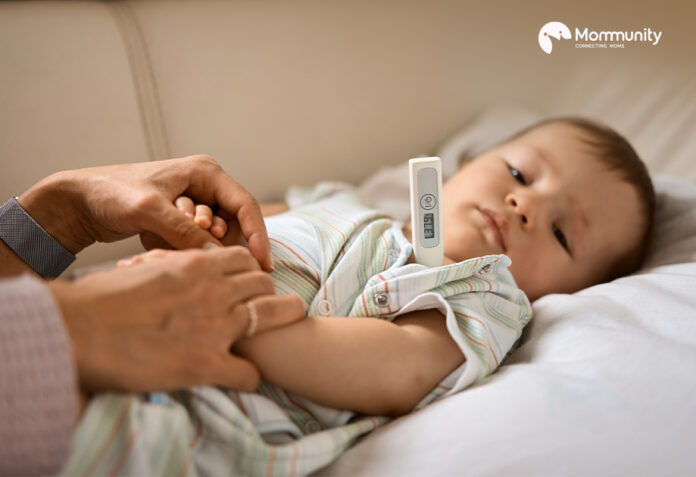Are you feeling something is not up with the baby’s temperature? Don’t know how to take babies temperature? Measuring babies temperature is a necessary thing to know. The maintained temperature shows the well being of the baby. High temperature can be a sign of various illnesses, and prompt detection can make a serious difference in care and comfort.
In this blog, we dive deep into the different methods to measure your baby’s temperature, which helps in making sure well-equipped to handle any situation.
Why Measuring Temperature is Important
Temperature is a key sign that can indicate your baby’s health status. Babies, especially newborns, have weak immune systems and can be more susceptible to infections. By monitoring their temperature, you can detect early signs of fever and seek medical attention if necessary.
5 Methods for Taking a Baby’s Temperature
1. Digital Thermometer (Rectal)
- Accuracy: Considered the gold standard for babies under three months.
- Steps:
- Clean the thermometer with rubbing alcohol or soap and water.
- Apply a small amount of petroleum jelly on the tip.
- Place your baby on their back, holding their legs gently in a bent position.
- Insert the thermometer gently into the rectum, about half an inch to an inch deep.
- Wait for the beep and read the temperature.
- Pros: Highly accurate.
- Cons: Can be uncomfortable for the baby.
2. Digital Thermometer (Oral)
- Accuracy: Suitable for babies over four years.
- Steps:
- Clean the thermometer with rubbing alcohol or soap and water.
- Place the tip under your baby’s tongue.
- Instruct your child to close their lips around the thermometer.
- Wait for the beep and read the temperature.
- Pros: Easy and quick.
- Cons: Not recommended for young babies.
3. Digital Thermometer (Axillary)
- Accuracy: Less accurate but useful for a quick check.
- Steps:
- Clean the thermometer with rubbing alcohol or soap and water.
- Place the tip in your baby’s armpit, ensuring it touches the skin.
- Hold your baby’s arm close to their body.
- Wait for the beep and read the temperature.
- Pros: Non-invasive and easy.
- Cons: Less reliable than rectal or oral methods.
4. Ear (Tympanic) Thermometer
- Accuracy: Suitable for babies over six months.
- Steps:
- Ensure the ear is clean and free of earwax.
- Gently pull the ear back and insert the thermometer.
- Wait for the beep and read the temperature.
- Pros: Quick and easy.
- Cons: Can be inaccurate if not positioned correctly.
5. Forehead (Temporal Artery) Thermometer
- Accuracy: Good for all ages.
- Steps:
- Ensure the forehead is clean and dry.
- Swipe the thermometer across the forehead.
- Read the temperature.
- Pros: Non-invasive and comfortable.
- Cons: Can be affected by external factors like sweating.
4 Tips for Accurate Temperature Measurement
Making sure that you take your baby’s temperature accurately involves several important steps. Here are some detailed tips to help you measure the correct temperature:
1. Consistency
It’s a little tough to use the same method each time you take your baby’s temperature. This practice checks that you can reliably compare readings over time. Switching between methods can be problematic sometimes, such as moving from rectal to oral, which can result in variations that might not accurately reflect changes in your baby’s temperature. By sticking with one consistent method, you maintain a clear and accurate record of your baby’s health.
2. Cleanliness
Before and after each use, always clean the thermometer thoroughly. Use rubbing alcohol or soap and water on the device to disinfect it. This step is essential to prevent the spread of germs. Proper cleaning maintains hygiene and confirms that the thermometer remains safe for repeated use.
3. Comfort
Keeping your baby calm is still required during the temperature-taking process. Babies can easily become uncomfortable, which might make it difficult to get an accurate reading. Try to soothe your baby by talking softly or holding them gently. Before measuring temperature, make sure they are comfortable. This will help you get a more accurate temperature measurement without any added stress or discomfort for your baby.
4. Timing
Avoid taking your baby’s temperature immediately after they have been fed or bathed. These activities can temporarily alter your baby’s body temperature, leading to inaccurate results. Wait for about 15 to 30 minutes after feeding or bathing before measuring their temperature. This waiting period allows your baby’s body to return to its normal state, providing a more accurate reflection of their temperature.
By following these detailed tips, the temperature readings you obtain are both accurate and reliable, helping you monitor your baby’s health more effectively.
Key Takeaways
Understanding how to take babies temperature is an essential skill for any parent by mastering the various methods of measuring temperature. You can make sure that your baby’s health is monitored accurately and effectively. Consistency, cleanliness, comfort, and proper timing are key factors in obtaining reliable temperature readings.
Remember, accurately measuring your baby’s temperature can make a difference in early detection and treatment of potential illnesses. Always consult with a doctor if you have any concerns about your baby’s temperature or overall health. By following this blog on how to take babies temperature, you can provide the best care and comfort for your little one.




